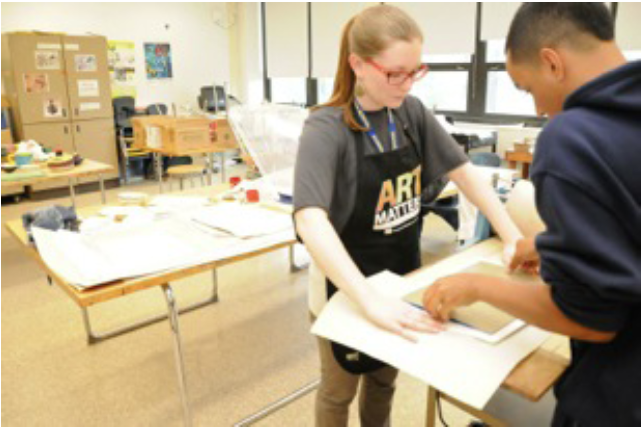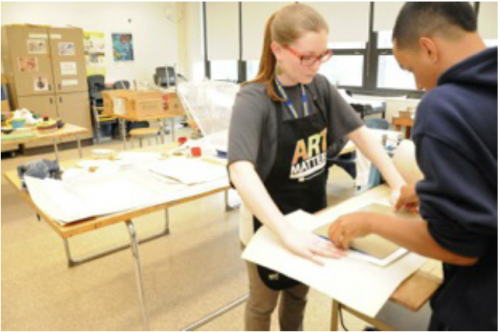
Alumni Spotlight: Hannah Weil
Hannah Weil graduated from CCC’s Art Ed MAT program in 2012. Last year, I visited her art room at the Harvard School of Excellence in Englewood, where her third graders were designing cityscapes. She has since moved on to James Ward Elementary School. Via email correspondence I asked Hannah a few of the questions I encounter as our program’s Grad Ambassador, as well as some of the things I am curious about in looking towards transitioning from grad school into the working life of a teacher.
What brought you to Columbia’s Art Ed MAT program?
After pursuing a bachelors degree that left me feeling unfulfilled, I decided it was finally time to bring my two passions together. I have always loved being around children and I have been passionate about art as far back as I can remember. What attracted me to Columbia’s ArtEd MAT program was knowing I was going to receive a world class education that was right next door to where I grew up. I knew that the city of Chicago would provide me with the perfect landscape for learning and Columbia was going to give me the tools to excel in that environment.
A lot of prospective students have been curious about the instructors in the program, do you have anything to say on that subject?
All of the instructors I had during my studies were extremely well versed on the subject of education. I felt completely confident that I was going to leave each course with a knowledge set that was going to help me grow and excel in the field of education. The great thing about Columbia’s Art Ed MAT program is you receive an education from both non-art teachers and art teachers. The perspectives I gained were not always how to teach art but how to teach, and I believe that knowledge has brought me to the place I am today. The art ed students spent the majority of time with our lead professor, Dr. Anne Becker. I have never felt more confident in my education than when I attended her classes. Her wealth of knowledge was absolutely contagious and I will never forget many of the things she taught us. One valuable statement I vividly remember is when she said, “There is always going to be that one student. That student that no matter how hard you try, they are just going to give you a hard time. All you have to do is find one thing, just one thing about them that is positive and hold onto that.” I have used this advice every year since leaving Columbia. I am always able to feel at ease when I get that one student, because I know that there is always something good I can find within them. Owing to Dr. Becker’s cultivating insights as a veteran art educator, I am able to walk into any interview or into any classroom ready and prepared.
What class did you learn the most from? How did the MAT program prepare you for the classroom?
That’s a tough question because so many of them were instrumental to my success as a teacher. I would say Classroom Management and Methods of Teaching Art for the different age levels were the two that stand out the most. What I learned in those courses I use, and will continue to use, on a daily basis. The Classroom Management course gave me a roadmap to be successful starting off as a new teacher. I have drastically changed that map after actual experience with my own classroom, but it set me up so that I would not feel like I was drowning during a very difficult time in any new teacher’s career. The Methods courses, under the guidance of Dr. Becker, provided me with actual teaching experiences specific to being in an art room. The processes and procedures of running an art room are so drastically different than a regular classroom and these courses teach you exactly how to navigate through it all. This includes how to deal with students, other teachers, administrators, budgets, and the list goes on. When it came time to run my own classroom I had no fears and only excitement that I could finally put all of the knowledge gained from Columbia to good use.
Have you kept in touch with your cohort?
Yes! Especially the ones also teaching in CPS. Whenever there is an all day Arts PD, we like to get together after for a drink or two and share stories and/or ask for advice.
What was your job search like after completing the program?
Interesting enough, I did not have to search much. The principle at my first school actually sought me out because I student taught at Roberto Clemente, a notoriously difficult Chicago Public School. With that said, my biggest piece of advice for incoming MAT students is to choose your student teaching placement wisely. If you student teach at a well-off school, it will be harder to sell yourself to high needs schools. If you student teach at a high needs school you open yourself up to far more opportunities to work throughout the entire city of Chicago. My second teaching job, that I transferred to this year, was made possible through a fellow cohort member who recommended me to their music teacher. The Columbia connection got me in the door, and the Columbia education gave me the confidence to show them that I was the best teacher for the position. However, if another Columbia MAT graduate had been going for the position, I might have been worried.
What are you doing now?
I am currently at James Ward Elementary School which serves 500 students, grades PK-8. It is in the Chinatown/Bridgeport area and has a fairly diverse group of students with a dominant Asian population.
What is the biggest challenge in being an art educator in Chicago/ in an urban setting?
The biggest challenge in being an art educator in Chicago, or with Chicago Public Schools, is needing to be ready for absolutely anything. My first year, I did not have any profoundly autistic students. By my second year, our school welcomed a cluster program from a neighborhood school that closed down. At my first school, I dealt with mainly behavior problems and now I deal with English language learners. The best part about all of the challenges I face is that before I even left Columbia, I was prepared to meet every single one of them. I strongly believe that learning in an urban environment lends itself to teaching in an urban environment.
What has been your most impactful moment as an art teacher so far?
When I started at Harvard Elementary I had a huge task ahead of me. My students, grades PK-8, had a seemingly simplistic art education that left them with very little to no vocabulary. Although a lot of work lay ahead of me, it was also exciting to cultivate a new artistic learning environment that was filled with all of the insights gained from my education at Columbia. My first year was spent giving all of the students, even the upper grades, the basic art terms over and over again. Along with vocabulary, it was important for me to expose students to art history. My second graders did a unit on Vincent Van Gogh. I filled my unit with math integration, standards, different mediums, and all of the goodies that Dr. Becker prepared us so well to do. Yes, I had a stellar unit, but nothing would prepare me for the gratification that would come later that year. At the end of a long day, I had one of my second grade students seek me out with excitement beyond belief to tell me what she had seen on their field trip to Legoland. With such joy she exclaimed, “We saw Vincent Van Gogh, Starry Night at Legoland!!” A child who could not even tell me what a primary color was earlier that year could now tell me that she had seen a famous work of art made out of Legos! The experience nearly brought me to tears when another second grader, and another, kept coming around the corner so excited that they got to see Van Gogh at Legoland.
How do you manage to make time for your own art while being a teacher?
It is a conscious decision that I maintain my own artistic practice while teaching. I do not have as much time as I used to, but I make sure to always have a painting on the easel ready to be worked on. That way, when I am feeling stressed, or bored, or eager to put some paint on the canvas, it’s ready for me. I think it is extremely important as an art educator to show your students that you are still actively engaging in art making yourself. Although we have not chosen to make a career out of creating our own art work, we must show students that we practice what we preach.


